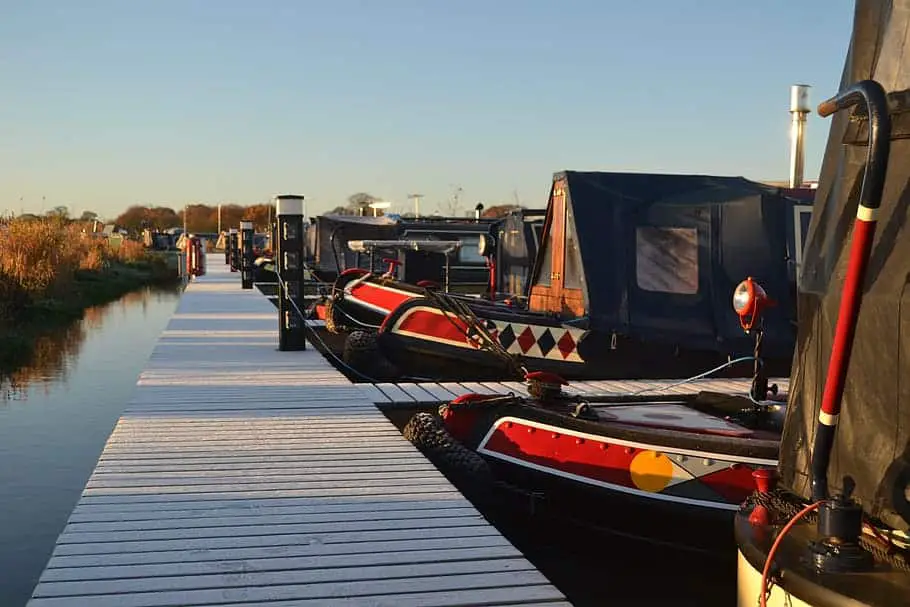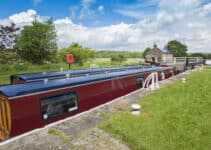Welcome back to CanalBoatUK. Today we are looking at narrowboat interiors, the different layouts available and tips we have for making the most of the rather compact interior you have to work with. We hope this will make a good starting point for anyone thinking about updating their layout or even buying a new one 🙂
The narrowboat community is an awesome one though, and we always seek advice from those with more experience than us. If you are a veteran narrowboater and have tips for us, please leave them in the comments section underneath this article.
On with the show! I mean article!
Narrowboat Interior Layout Options
When most people talk about narrowboat interior layouts, there are two main ones to start with. Here’s a simple graphic to show them, and some text explanations underneath 🙂

Traditional
Back in the day, the traditional setup for a narrowboat interior would be to have the berths (or beds) at the rear of the boat. This is what you will see a lot, especially in older boats. The problem with this is that the person steering the narrowboat feels quite lonely, as there is nowhere for his or her companions to easily hang out and give moral support. This is the main reason that people have started to move away from only using this more traditional design.
As I have tried to state in the graphic above (sorry for the MS paint design skills!), this social element can also be achieved by having a cruiser stern to create a larger deck area to encourage crew to chat to the person steering.
Below is the typical example of a cruiser stern, allowing you to have more room to stand and chat. I even see people put a table and chairs out there, too.

This would be a way to keep your boat social and with a traditional layout, if that’s what really floats your boat (no pun intended!!).
As a literal halfway house, you can also get a semi-traditional (semi-trad) stern that has a couple of wooden benches in an area directly in front of the steering position. Although these days, most people seem to like going for the more open design of the cruiser stern.
The one great plus that a traditional layout has is the fact that the saloon can look so bright and inviting. It can be right at the front of the boat with additional light coming in through windows in the front doors. Some of the most light and airy feeling saloons I have seen in narrowboats have been in the traditional layout. Looking out the front doors and watching the world go by is a pretty awesome bonus here! Your access to the front deck will be easier in this setup too, meaning dining out there could be a possibility. With a bedroom in the way, it becomes a lot harder.
Other than this (for me personally), there are too many downsides to the traditional layout to warrant choosing it. Please feel free to let me know if you disagree.
Firstly, when one’s boating companion wishes to take an afternoon nap, this is rather hard to achieve when the main bedroom/ berth is at the back where all the action is happening. Also, a bedroom at the back is far more likely to get messed up with muddy paws/ boots or whatever. Simply being near a constant open door doesn’t help 🙂
If you spend a lot of time moored up, you may prefer this layout. This is because whilst moored your main point of entry and exit is often the front of the boat. This means in your case most of the action is moved to the that part, and you can enjoy a light and airy saloon to boot! Even some moonlight dinners on the front deck 🙂
Reversed
As you can see from my graphic above, the reversed layout is as it sounds. The berths are switched to the front of the boat, with the galley and saloon taking their place at the back. In my example above, I have the saloon at the very back. Another popular option is to have the galley at the back, making it the perfect place to whip up a quick cup of tea or a cheese sandwich. The fact that you have such an accessible kitchen/saloon area is what makes this layout so popular. Most narrowboats are manned by couples, and the reversed layout seems to suit them best. Whilst one is making lunch, the other can be cruising along. Both in close contact at all times 🙂 The downside is you will find it harder to get the most of out of your saloon area.
If you are continuous cruisers and spend a lot of time moving around the waterways (and like being in constant contact), this is probably the layout for you. Having your kitchen and saloon connected to the area where the boat is being steered would make a lot more sense if you are often out on the water.
If you are a dog lover, the reverse layout might also prove a winner. When they get wet and muddy, you don’t have to let them into the main living space until they have dried off in the galley.
As this layout usually has the main bedroom at the front of the boat, some like the option to go for a sealed bow. This would basically mean the bow door is sealed and not used, allowing you to have your main bed stretched the whole width of the boat.
The final thing to say when you are deciding the main interior layout is where are you going to store your wood and coal. These are essentials all boaters need (especially in Winter), so they need to be factored in.
For example, if all your wood and coal has to be stored in the front of your boat and you have a reversed layout, it will all have to be brought through the bedroom to get to the stove. This is probably not ideal. As storage varies from boat to boat, you will need to consider this element in your plans.
Anything Else to Consider about my Narrowboat Layout?
If only it was that simple! Of course there’s more to consider! Read on…..
Bathroom
I am not going to discuss the fittings. That would be for another day! If you want to read more about toilets, we have a whole other article over HERE for that, for example. Today we are going to concern ourselves mostly with the layout.
A lot of people don’t realise that they actually have a choice here. The typical narrowboat bathroom will consist of a small room next to a thin corridor or passage, meaning the bathroom will often be just over half the width of the boat.
If this doesn’t impress you much, you can go for a walk-through bathroom that takes up the whole width of the boat. Naturally, the downside here is that you have to walk through the bathroom to pass through that part of the boat (usually when going from the bedroom into the main living space). This is often fine if you are on board alone or with a partner you have known a long time, but is still not the ideal situation. How much are you willing to do for a bigger bathroom??
The other about walkthrough bathrooms is to make sure the toilet is not visible when you open the doors. I have seen quite a lot where someone sat on the toilet would be clearly in view as soon as a bathroom door is opened, again far from ideal 🙂
The Boatman’s Cabin
This is a very traditional looking cabin at the rear of a narrowboat. When narrowboats were used as the logistic backbone on the UK (a long time ago clearly), they were working boats. The Boatman’s cabin would be the sleeping area for the workmen on the boat, and maybe even their family. In my experience, these are not used or included in modern layouts any more. The only time I see them is when someone has a real interest in the traditional side of canal boating, or they simply have a crazily long boat and have more than enough space to accommodate it ‘for fun’.
If you want to see one for yourself, the best way is to befriend a owners of a coal boat or other boats that still work on the canals. Either that or just watch a video on Youtube 🙂

Dinette Talk!
No narrowboat interior talk wouldn’t be complete with bringing up the subject of dinettes. These are basically the small areas used as a substitute for a dinner table, and usually double as a sleeping berth to boot. If you live in a particularly small boat, you may opt to not have a dinette and use the saloon area for eating instead!
If you do decide you want a dinette, you can go for either an L-shaped or a Pullman dinette. Think of the Pullman as the arrangement you used to see in old train carriages (probably because that’s where the idea came from!!). Two bench seats are positioned face to face with a table in the middle. Pretty simple stuff, really. When seating two people, you will often see two thin chair like benches positioned longways against a wall. For seating four you will find that the Pullman dinette often has to span the full width of the boat. This is why some people opt for the L-shaped….
The L-shaped is….well…. L-shaped 🙂 This means it won’t take up as much space as the more traditional Pullman. This seating arrangement reminds me more of what you might see in a modern caravan or motorhome.

General Design Tips and Narrowboat Interior Hacks
In this article we will not be diving into details such as exact fittings and such like. This is more of an overview of what you need to consider when thinking of a narrowboat layout. Now we have some basic tips to help you get your Narrowboat interior looking the best it can be!
Light Interiors
Narrowboats are rather tight on the inside (unless you have a massive widebeam of course!). For most of us, this compact nature can be made to feel airy and more spacious by using lighter color paints inside. If you go too dark, it will make your narrowboat seem gloomy and dark. For most, the light and airy approach would give the impression of more space. Bright colours can also help with this, but try not to go overboard 🙂
Personally, I love narrowboat interiors that have a solid white or white washed look to the walls.
Windows
Consider the windows in your boat. Portholes are good for spaces you wish to keep private, such as the bathroom and bedroom. But make sure they are not used too much in the main living areas. You want bigger glazed windows for these areas to make sure you are getting a good amount of light into the boat. Also, fit some simple blinds that are quick to put up and down. This will encourage you to use them more and be another way to get more light into the boat.
Kitchen Doors Might Do It!
I have seen people rip apart whole kitchen arrangements when a simple sanding down and painting of kitchen cupboard doors would be more than enough. You will be amazed of how much of a difference this simple improvement will achieve.
Shelving
With such a compact space, you need to get creative with your storage. We have all seen the narrowboat steps that double as a storage cupboard, right? Ikea have a good deal of cheap shelving and hanging storage systems that will improve your storage problems no end. Putting a plate rack up on the wall rather than stacked in a cupboard would free up a lot of space, for example. This makes your walls more useful, and if done tastefully can still look very ‘farmhouse’ like and attractive on the eye 🙂
Carpet No More
If anyone is tempted to put carpet in their narrowboat, think again 🙂 Damp is the enemy of any boats on the canal, and carpet will hold on to any excess moisture and make it worse. Vinyl flooring has been popular in land based homes for many years but it is also a quick and cheap way to get rid of carpet on a canal boat too 🙂 Of course, solid wood floors give a great farmhouse feel if you can stretch that far.
Consistent Theme
Pick a theme for your narrowboat’s interior and stick to it. Popular themes include farmhouse, modern, minimalist and retro styled interiors. By having a clear theme in mind, you will end up with an interior that has a much more consistent and unified feel.
If you are still struggling for ideas after all of this, you can try this interior design book specifically aimed at narrowboats.

It’s all Layed Out!
Well, there you go! I hope you got some value out of our tips and advice for the interior of your narrowboat. Of course, I am always learning, so expect this article to get updated more over time. If you have any narrowboat interior design experiences you would like to share with us, please do so in the comments section below.
Happy boating!
Pinterest is a social media platform which is very image based, so it is a great place of inspiration for narrowboat interior design ideas. Put simply, there are many amazing photos over there that will give you inspiration for days. Just look at the Mothership Marine profile below for a prime example 🙂



![What Happened to Cruising The Cut [Narrowboat Youtuber]](https://canalboatuk.com/wp-content/uploads/2022/08/cruising-the-cut-youtube-channel-211x150.png)

Any custom designs featuring a wheelhouse? After riding motorcycles 35 years in all weather, in my retirement I want to be out of sun and rain, unless I want to. I want outdoor seating to relax, but not standing outside to steer.
Hi Randy, if you want a wheelhouse you might want to look into a river cruiser that fits on the canals. There are dutch barges with wheel houses, but they are usually widebeam, making them slightly restrictive on canals. Regular narrowboats can get pram covers but these are designed more for adding space to your narrowboat when moored up.